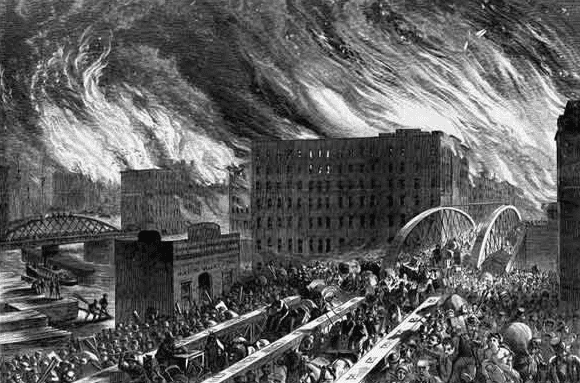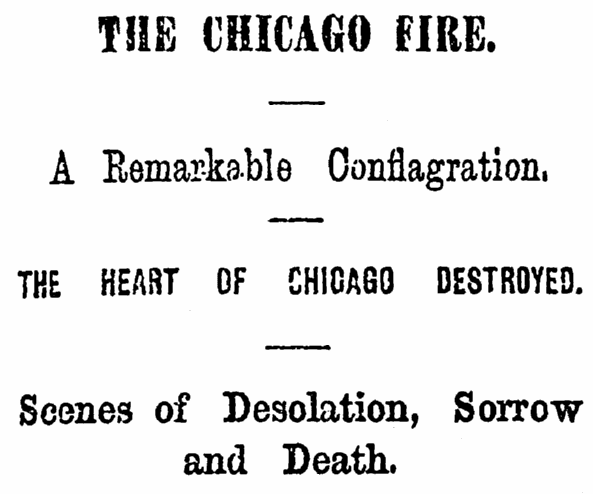Introduction: In this article, Scott Phillips searches old newspapers to learn more about some of the major fires in our country’s history—including one he and his family lived through—and reminds genealogists how important it is to make copies of your family history research so that a natural disaster doesn’t destroy years of work. Scott is a genealogical historian and owner of Onward To Our Past® genealogy services.
Fire, fire, fire raging all about. Who’ll call the fireman to put the fire out?
—first line of a children’s song
If you grew up in the 1950s you may well recall this song. Details of the author, full lyrics, etc., seem to be lost to time, but after reading about a fire recently in the newspaper I began to research fires and their possible effect on our genealogy and family history work.

Personally, I remember all too well the fire that ravaged my in-laws’ home. Although the house was saved the damage was extensive, and many heirlooms, pictures, etc., were lost forever as a result. It was a good lesson that taught me: genealogists should back up all their family history work and keep a copy of that backup somewhere other than in their home, unless they have a fireproof vault!
Great Chicago Fire of 1871
It is hard to look at famous fires throughout U.S. history and not begin with the Great Chicago Fire of 1871. One of the more detailed articles I discovered in GenealogyBank’s Historical Newspaper Archives was from this 1871 Massachusetts newspaper. This detailed news story covers almost a full page and reports: “…over 10,000 buildings are in ruins. The fire is still raging…” The article also reports that no one was spared, from “the dwellings of the mass of the German population of the city” to “some of the oldest and best residences of the city.” More than 100,000 people were left homeless by the two-day inferno. Finally on the second night a heavy rain did what the fire fighters—whose water supply had been cut off by the blaze—could not. The rain put the Great Chicago Fire out, but not before more than 17,000 buildings were destroyed at an estimated loss of over $200 million in property—in 1871 dollars!

San Francisco Earthquake and Fire of 1906
It was in the early morning hours of 18 April 1906 when the earth rumbled, heaved, and shook terribly beneath the city of San Francisco. I found details in this 1906 Arkansas newspaper. As I read this article, I was struck by the fact that while I certainly recalled learning about the San Francisco earthquake in history class, I was not aware that fire raged across the city for three days afterward and actually caused most of the damage. Broken water mains prevented firemen from dousing the flames, and allowed the fire to move unhindered—eventually consuming over four square miles of the city. The earthquake and fire resulted in more than 3,000 deaths, left some 225,000 people homeless, and destroyed 28,000 buildings.
As I researched the news about this famous fire more, I found a very interesting article published in a 1907 Michigan newspaper. While the headline writers make it seem as though the San Francisco earthquake and fire was the year’s worst disaster, this extensive article admits this may be only “in the interest of the people of the United States” since “Hongkong” (sic) was ravaged by a three-day typhoon that devastated the city and cost an estimated 5,000 lives; a major earthquake destroyed Valparaiso, Chile, and damaged nearby Santiago causing the loss of between 1,500 and 2,000 lives; and in Italy, Mount Vesuvius erupted killing more than 2,000 and obliterating four towns and several villages. Natural disasters know no boundaries and can reach us in huge cities or tiny towns—and all this was just in the one year of 1906.
Cerro Grande Fire of 2000
Not many years ago, my family and I lived in Santa Fe, New Mexico. During our time there we witnessed the “Cerro Grande” fire. I found a good article about this fire in a 2000 Illinois newspaper. Not only did this major fire force the closure of the famed Los Alamos National Laboratory, but it resulted in the evacuation of every one of the town’s 11,000 residents. While the nuclear materials at the Laboratory were all safe within fireproof facilities, many homeowners were not so lucky.
A year later, there was a follow-up article in this 2001 Connecticut newspaper. This old news article begins poignantly with this:
The tears come for Lucy Thomas when she thinks about the family Bible and other precious possessions that burned in the Los Alamos fires a year ago.
Ms. Thomas was not alone either. The article reports that more than 220 structures were destroyed by the fire leaving more than 400 families homeless; the fire destroyed or damaged a further 115 buildings at the Laboratory; and burned over 43,000 acres of timberlands.
Each morning during that fire, I well remember waking up to smoke throughout our yard, ash over an inch deep covering everything in sight, and the air quality monitor the EPA put at the end of our driveway. Shortly after the fire I had a meeting in Los Alamos and, while driving through the town, I was stunned at the complete and total destruction of so many houses. This brought the threat closer to home than we would have liked, but it also acted as a warning that fire can happen anywhere—and we had better be prepared for the possibility of the worst happening.
Capitan Fire of 1950
My newspaper research then brought me to an article regarding fires that could finally make me smile. It was in a 1954 newspaper from Washington, D.C. This story was about the famous Smokey Bear, who was rescued by firefighters during the Capitan fire in New Mexico in May of 1950.
An early news report of this fire in a 1950 Nebraska newspaper was headlined: “Central New Mexico Forest Fire Unchecked.” That news reporter couldn’t have known that a national treasure would be found, with singed paws and legs, clinging to a burned pine tree!
As the examples in this article have shown, old newspapers are a great way to learn about the major events that impacted our ancestors’ lives, and the news that affected them. And these reports of the devastating power of fire and the overwhelming destruction it can cause serve as a powerful reminder that no home—and no collection of family records, documents and photos—is ever completely safe. Be sure to digitize your material and store it safely online, preferably on at least two different websites!
Related Articles about Records Preservation: